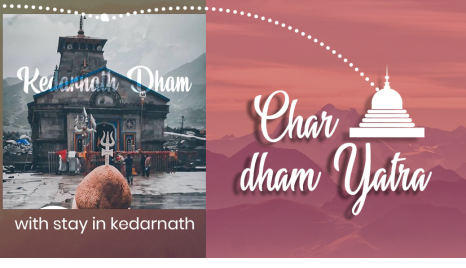Char Dham Yatra stay in Kedarnath | Trekveda
March 20, 2020
 Char Dham Yatra stay in Kedarnath | Trekveda
Char Dham Yatra stay in Kedarnath | Trekveda
On this day you drive to Barkot from Haridwar via Mussoorie, and Kempty Fall. Treat your eyes with the whole beauty of mountains while driving to Barkot. It will take 6 to 7 hrs to reach Barkot. Drive early as possible to reach on time, and after reaching Barkot relax. Later, explore the majestic environment and restore your energy for the next day.
On this day from Barkot you drive to Janki chatti. And from there the trek to Yamunotri starts that is around 6kms. As you walk by, you pass through lush green valleys. You witness Conifers, Rohodendrones, cacti’s, and several other species. Later reach Yamunotri see the beauty of this pilgrimage. Maharani Gularia of Jaipur built the temple in the 19th Century. It was destroyed twice in the present century and rebuilt again. At Yamunotri, Pilgrims take this cooked rice home as “Prasad”. Here near the temple “Pooja” can be offered to Divya Shila.
On this day Drive to Harsil, it is a drive of 6 to 7 hrs. After reaching the hotel take a rest and then explore the destination. Harsil is located on the banks of the River Ganga. The small beautiful village has all the beauty, apart from the dense deodar forests, Harsil offers spellbinding views of the apple orchards. On arrival, check-in to your hotel and enjoy an overnight stay.
On this day you drive to Gangotri. Gangotri the holy place known for Hindus. Take a dip into holy Bhagirathi River, which is the origin of River Ganga. Later stay connected to the majestic beauty for an hour or two then drives back to Uttarkashi. Gangotri temple was constructed by the Gorkha General Amar Singh Thapa in the 18th Century, is situated on the right bank of Bhagirathi.
On this day drive to Guptkashi via Moolgarh and Lambgoan. Witness the Mandakhini River at Tilwara. The river Mandakhini comes from Kedarnath. Also visit Ardh Narishwar Temple. The place name GuptKashi means “Hidden Benares. Mythology describes how when the Pandava brothers were searching for a glimpse of Shiva, Shivji first concealed himself at Guptkashi, but later fled from them further up the valley to Kedarnath, where the Pandavas finally got their wish fulfilled.
On this day start early in the morning move from Guptkashi to Kedarnath via Sonprayag that is going to be a different experience for you as this route will be a new one. As you reach to Kedarnath, after freshening up perform Pooja at the temple and Darshan of Shri Kedarnath. In the evening also visit Adi Shankaracharya Samadhi behind the temple, overnight stay there.
On this day wake up early, and move back to Sonprayag from Kedarnath and later to Guptkashi. Overnight stay in Guptkashi.
On this day after breakfast, drive to Badrinath. Pilgrims after having a bath in the Taptkund have the Darshan of Badrivishal & Aarti in evening. Brahma kapal is significant for Pinddan Shraddh of ancestors. There are other interesting spot like Mana, Vyas Gufa, Maatamoorti, Charanpaduka, Bhimkund and the “Mukh” of the Saraswati River. Just within the 3 Kms of Badrinath. Overnight stay at Badrinath.
On this day travel back to Shrinagar from Badrinath, wake up early morning and take a bath in Tapt Kund, and after visiting the temple you can enjoy the beauty of Mana village, the last Indian village before Tibet; Vyas Gufa, where sage Vyas scripted the Hindu epic Mahabhartha; Charan Paduka, where you can find Lord Vishnu’s footprints. Beauty likes Narad Kund, Bhim Pul and Vishnuprayag. Later drive to Srinagar via Rudraprayag.
On this day as this is the last day of your char Dham yatra. Drive back to Haridwar, post breakfast takes a six-hour drive to Haridwar via Devprayag. Devprayag is one of the punch Prayags. You can take a halt and visit Devprayag, visit the Raghunathji Temple. Dedicated to Lord Vishnu, the temple is believed to be built in the 8th century.
